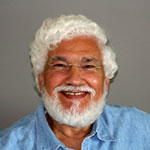March 31, 2010
A walk through Islamic Cairo

CAIRO, Egypt - I was treated to a walk through Cairo's recently restored Al-Muiz-le-Dinnallah street in Islamic Cairo, an open museum of the world's most beautiful Islamic architecture of mosques, schools, homes, palaces, hospitals and public drinking fountains.
It's sad but true, that less than one per cent of historic Islamic Cairo is accessible to tourists; and this despite the fact that Cairo boasts the world's largest concentration of Islamic monuments in any single city. These Islamic monuments tell the history of this great city over more than a millennium, a period spanning the seventh through the nineteenth centuries.
Fortunately, there are half-a-dozen great mosques in this city that are still accessible to tourists and all should be must-see stops on the traveler's itinerary.
First, there is the Amr Ibn Al-As mosque from 641 AD, the first built in Egypt and in all of Africa.
Coming more than two centuries later is the mosque of Ahmad Ibn Tulun, built in 868 AD. Then in 989 AD the mosque of Al-Azhar and its university -- the oldest institution of its kind in the world -- were founded.
The famed Cairo Citadel, built in 1176 AD by Salah Al-Din (or Saladin) was joined much later by its Mohamed Ali mosque, in 1824 AD. Two other majestic nearby mosques are the Sultan Hassan mosque from 1347 AD and the Rifa'i mosque, begun in 1819 AD and completed nearly a century later, in 1912 AD.
There are actually four cities within historic Cairo.
The oldest is Al-Fustat, built by the Arabs when they entered Egypt via Sinai in 641 AD to liberate it from the waning Roman Empire. These Arabs arrived first in Alexandria, but they needed a base further away from the Mediterranean ports where the Roman navy was stationed, yet not too far from their native Arabia. So they established Al-Fustat on the east side of the Nile (today called Misr Al Qadema, or Old Egypt).
Within Al-Fustat you will find not only historic treasures of Islam, but also some of the world's oldest churches and synagogues (so much for the idea of spreading Islam by the sword!).
Al-Fustat is not only a must-see cultural and historic site -- it is also very tourist- friendly.
A century after the Arabs came to Egypt, another city called Al-Asker was built nearby in 750 AD (today, this historic area is part of Cairo's Sayyida Zaynab district.); it later expanded to join Al-Fustat as a single city called Al-Qata'i. This combined city lasted until 904 AD when much of it was destroyed by fire, leaving the original Al- Fustat as the capital.
Al-Fustat continued to thrive as an elegant city by the Nile, with palaces, markets, houses, an incredible 36,000 mosques and 1,170 public baths!
Finally, the fourth historical city to emerge was Al-Qahira (the Victorious City, in Arabic), a new urban centre built by the Fatimids who came from North Africa in 969 AD. Later, Italian and Greek traders pronounced the city's name in shortened style as Cairo, the name it bears today.
The first Fatimid ruler of Egypt was Al-Muiz-le-Dinnallah (in Arabic, One Who Gives Might to God's Religion).
A street in the heart of Islamic Cairo, the one I spent a 5 hour walking tour to see its treasures, is named in his honour and along it, one can find some of the most exquisite examples of Islamic architecture, in mosques, schools, palaces, houses, open markets, and even in the public drinking fountains.
Al-Muiz-le-Dinnallah was so influential in the building and design of the city that it became known as Qahira-tul-Muiz, the Cairo of Al- Muiz; and he continued throughout his reign to gradually improve the city with an eye for beauty and elegance in every detail.
By the beginning of the 1400s AD, however, the grand street and neighbourhoods of Al-Muiz were slowly turned into a commercial and trade centre for the whole of Egypt.
Every artisan and trades profession wanted to locate workshops and stalls there, so that whole sections and blocks became identified with specific products. For example, the area devoted to tent-making still exists by its trade name, Al-Khiyamia.
Like most ancient cities Al-Qahira once had many gates (called Bab) for
protection; today, four still survive.
To the North you can find Bab Al-Futuh and Bab Al-Nasr, both established in 969 AD by Gawhar Al-Sakaly, leader of the army for Al- Muiz.
These two gates were later refurbished in 1087 AD by Badr Al- Gamali, who also built two more at Bab Zuweila to the South.
Back in the fourteenth century, Muslim social scientist Ibn Khaldun, father of modern Sociology, wrote about Al-Qahira:
"I saw the metropolis of the world -- Orchard of the Universe, beehive of nations ... human anthill, gateway of Islam, throne of royalty, sparking with palaces and gates, shining on the horizon with monasteries and schools, illuminated by the moons and stars of its learned men -- appear on the bank of the Nile, river of Paradise."
No wonder Egyptians say that Al-Qahira was built by a man who used to be a Halwany (sweet maker) meaning it was a labour of love that made Al-Qahira what it still is today -- a Jewel on the Nile.
To learn more about Cairo, I strongly recommend two books, both published by the American University in Cairo Press.
First, there is Cairo -- City of History, by Prof. Andre Raymond. This popular academic reference book was written originally in French and later translated into English. The author was Director of the French Institute for Arab Studies and is Professor Emeritus at the University of Provence in France.
And equally recommended is a unique and practical guide called Historic Cairo -- A Walk through the Islamic City, by Jim Antoniou, a British architect and city planner who illustrated this book with many of his own lovely original drawings of the old city.








